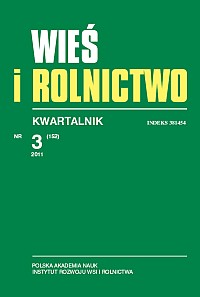Efektywność ekonomiczna różnych wariantów zmian wspólnej polityki rolnej na podstawie symulacji w modelu GTAP
Economic efficiency of different variants of Common Agricultural Policy changes – basing on a simulation in GTAP model
Author(s): Bazyli CzyżewskiSubject(s): Economy
Published by: Instytut Rozwoju Wsi i Rolnictwa Polskiej Akademii Nauk
Keywords: agriculture; GTAP model; single area payment scheme (SAPS); Common Agricultural Policy (CAP); input-output tables
Summary/Abstract: Growth of real productivity in farming, attributable, for example, to technical innovations, should, theoretically, result in higher incomes and the achievement of economic rent by the farms' owners. With the passage of time the economic rent disappears due to the striving for allocation efficiency. This mechanism does not prove true, however, in Polish agriculture because benefits stemming from higher productivity are being intercepted by other sectors of the economy. This situation can be blamed on the deficiencies of the market mechanism. Structural changes in the agricultural sector brought about by the integration with EU tend to limit these deficiencies. However, their corrective impact is not sufficient, while the rent allocation is characterized by the asymmetry to agricultural environment in the long term. This is why, the rents’ allocation structure should be considered as an economic efficiency criterion of changes in the Common Agricultural Policy after 2013. The aim of the article is to compare the structure of rent allocation in Polish agriculture in the five different variants of CAP evolution and to identify the most efficient one, according to the criterion presented above. A simulation has been made using the computable general equilibrium model and the GTAP (Global Trade Analysis Project) database, with the author applying an unconventional type of closure. The author formulates a hypothesis that the present system of Single Area Payment Scheme (SAPS) in Poland is not an optimal one in terms of the economic rents’ allocation and that it does not compensate for a long-term market asymmetry in this respect.
Journal: Wieś i Rolnictwo
- Issue Year: 152/2011
- Issue No: 3
- Page Range: 9-36
- Page Count: 28
- Language: Polish

